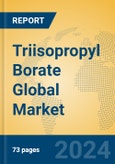Regional Market Trends:
Asia, led by Japan and South Korea, dominates Triisopropyl Borate consumption, with a CAGR of 2.5% to 3.5%, driven by their electronics industries. China also contributes, with growth in pharmaceuticals and electronics. North America, particularly the United States, projects a CAGR of 2.0% to 3.0%, supported by pharmaceutical demand. Europe, with markets like Germany and France, expects a CAGR of 1.5% to 2.5%, reflecting steady specialty chemical needs. Emerging markets in Latin America and the Middle East anticipate growth rates of 2.0% to 3.0%, tied to industrial development.Applications:
Triisopropyl Borate’s applications include liquid crystal materials, pharmaceuticals, and other uses, each with distinct trends.Liquid Crystal Materials:
- The primary segment, used in LCD production, projects a CAGR of 2.0% to 3.0%, driven by electronics demand. Trends include shifts toward next-generation displays and potential competition from OLEDs.
Pharmaceuticals:
- Used in drugs like crizotinib, this segment expects a CAGR of 3.0% to 4.0%, supported by oncology advancements. Trends focus on targeted therapies and personalized medicine.
Others:
- Niche uses, like specialty intermediates, project a CAGR of 1.5% to 2.5%, with limited growth due to their specialized nature.
Key Market Players
The market features key producers like Anderson Development Company (ADC), renowned for boron chemistry expertise. Alkali Metals Ltd contributes with its technical capabilities, while Jiangsu Hongzi New Energy Science & Technology Co. Ltd., with a 500-ton capacity, serves electronics and pharmaceutical markets.Porter’s Five Forces Analysis
Threat of New Entrants:
The threat is low, due to high technical barriers and a small market size.Bargaining Power of Suppliers:
Suppliers have low power, with raw materials like boric acid and isopropanol widely available.Bargaining Power of Buyers:
Buyers in electronics and pharmaceuticals hold high power, leveraging their scale in this niche market.Threat of Substitutes:
The threat is moderate, with alternative boron compounds potentially viable but less preferred.Industry Rivalry:
Rivalry is low, with few players competing on quality and innovation.Opportunities and Challenges
Opportunities
Growth in LCD production and new pharmaceutical applications offer potential.Challenges
Shifts to alternative display technologies and the need for pharmaceutical innovation pose risks.This product will be delivered within 1-3 business days.
Table of Contents
Companies Mentioned
- Anderson Development Company (ADC)
- Alkali Metals Ltd
- Jiangsu Hongzi New Energy Science & Technology Co. Ltd.








